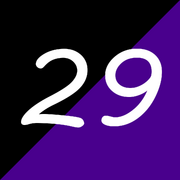No edit summary |
m (Removing vandalism) |
||
| (25 intermediate revisions by 9 users not shown) | |||
| Line 5: | Line 5: | ||
|roman-number = XXIX |
|roman-number = XXIX |
||
|ordinal-number = twenty ninth |
|ordinal-number = twenty ninth |
||
| + | |cardinal-number = twenty-nine |
||
| − | |previous = [[23|<font color="white">23</font>]] |
||
| + | |Base-2 Form = 11101 |
||
| ⚫ | |||
| + | |Base-8 Form = 35 |
||
| + | |Base-16 Form = 1D |
||
| + | |previous = 23 |
||
| + | |next = 31|standard-form = 2.9{{E|1}}}} |
||
| ⚫ | |||
==Proofs== |
==Proofs== |
||
| + | *{{Divisibility number|Yes|1.}} |
||
| − | *1 can divide 29 |
||
| + | *{{Divisibility number|No|2-28.}} |
||
| − | *2 cannot |
||
| + | *{{Divisibility number|Yes|29.}} |
||
| − | *3 cannot |
||
| ⚫ | |||
| − | *4 - 28 cannot |
||
| + | |||
| ⚫ | |||
| + | ==As an Exponent of Mersenne Number== |
||
| + | 2<sup>29</sup> - 1, which is the number 536,870,911, can be factored into [[233]] x [[1,103]] x [[2,089]], and therefore not a prime number. |
||
| + | |||
==Relationship with other odd numbers== |
==Relationship with other odd numbers== |
||
===The numbers before=== |
===The numbers before=== |
||
| − | *The previous prime number is 23. The numbers in between are composite |
+ | *The previous prime number is 23. The numbers in between are composite. |
**Among them, 25 is a square number, being 5<sup>2</sup> = 25. |
**Among them, 25 is a square number, being 5<sup>2</sup> = 25. |
||
**27 is a cube number, being 3<sup>3</sup> = 27. |
**27 is a cube number, being 3<sup>3</sup> = 27. |
||
| + | **23 and 29 are six numbers apart; therefore, they are sexy primes. |
||
| + | |||
===The numbers after=== |
===The numbers after=== |
||
*The next odd number, 31, is a prime number. |
*The next odd number, 31, is a prime number. |
||
| − | **There are no odd numbers between |
+ | **There are no odd numbers between 29 and 31. As a result, they are twin primes. |
*33, the odd number following 31, is not a prime number. It is divisible by 3 and 11. |
*33, the odd number following 31, is not a prime number. It is divisible by 3 and 11. |
||
*35, the odd number following 33, is also not a prime number. It is divisible by 5 and 7. |
*35, the odd number following 33, is also not a prime number. It is divisible by 5 and 7. |
||
| Line 27: | Line 37: | ||
[[Category:Prime numbers from 1-100]] |
[[Category:Prime numbers from 1-100]] |
||
[[Category:Prime Numbers]] |
[[Category:Prime Numbers]] |
||
| + | [[Category:2-Digit Prime Numbers]] |
||
| + | [[Category:Twin Primes]] |
||
| + | [[Category:Additive Primes]] |
||
| + | [[Category:Sexy Primes]] |
||
| + | [[Category:Chen Primes]] |
||
| + | [[Category:Russian-doll primes]] |
||
| + | [[Category:Multiplicative Persistence 2]] |
||
Revision as of 16:23, 3 May 2018
29 is a prime number from 1-100. 29 has 2 factors, 1 and 29. It is said to be another number wherein when digits are added together, they make a prime number. It is the tenth prime number, and the tenth prime number from 1-100.

Proofs
- Therefore 29 has 2 factors
As an Exponent of Mersenne Number
229 - 1, which is the number 536,870,911, can be factored into 233 x 1,103 x 2,089, and therefore not a prime number.
Relationship with other odd numbers
The numbers before
- The previous prime number is 23. The numbers in between are composite.
- Among them, 25 is a square number, being 52 = 25.
- 27 is a cube number, being 33 = 27.
- 23 and 29 are six numbers apart; therefore, they are sexy primes.
The numbers after
- The next odd number, 31, is a prime number.
- There are no odd numbers between 29 and 31. As a result, they are twin primes.
- 33, the odd number following 31, is not a prime number. It is divisible by 3 and 11.
- 35, the odd number following 33, is also not a prime number. It is divisible by 5 and 7.
